|
It's been a big last couple of weeks around the lab with several awards and presentations.
First, Irene Sánchez González won the Ralph Chermock Prize which is presented to the most outstanding students in the Department of Biological Sciences for natural history and evolutionary biology. Irene also won the UA Museum Studies scholarship, furthering her studies in the field. Following that, many lab members (i.e., Garrett, Irene, Jonathan, Matt, Taylor, and Carla) + honorable mentions (Jamie Bucholz) traveled to Portland, Oregon for the biennial Freshwater Mollusk Conservation Society meeting. Everyone participated by giving talks and/or posters. Most of us lost our voices in the process. Matt Lodato gave an excellent presentation and won the Best Student Platform Presentation award! Nice work Matt! In addition, despite most of the lab being gone or busy with other tasks, Caleb and Ian (WUNDERGRADS!) gave poster presentations at the Undergraduate Research and Creative Activity symposium at the University of Alabama. Great job Caleb and Ian!!
0 Comments
Well! The summer has flown by and so much has happened since the last post! The lab group has been busy over the summer conducting field work across Alabama, in Georgia, Tennessee, and Alaska. It has been an incredibly busy summer with field sampling across multiple streams and watersheds as well as experiments. Two manipulative experiments occurred as part of the Mussel Dimensions Project and AIMS. For the Mussel Dimensions Project, we are conducting a reciprocal transplant experiment across two different river basins with two separate species (one species per basin) to determine whether environmental context influences the gut microbiome while also tracking growth and stoichiometry. For AIMS, we conducted a manipulative stream drying experiment to address how drying and rewetting controls the biogeochemical template and microbial and macroinvertebrate communties! We are also testing out metabolic chambers as part of Atkinson's Career grant to isolate the impact of mussels on in situ biogeochemical processing and stream metabolism!
Since the last update, here are some major milestones: - August 2022
- July 2022
- June 2022
- May 2022
A big congratulations to Taylor Kelley and Lacey Kohler (wundergrads in the lab) on getting their research proposals funded by UA's ASSURE grant! Taylor will be studying crayfish community structure and abundance in stream reaches that vary in intermittence in one of the AIMS study watersheds in Greene County, Alabama. Lacey's work is in the same watershed which is owned by Weyerhaueser Company, a forestry company. She will be studying how the construction of roads and other silvicultural activities may be impacting sediment transport in streams using an experimental Before-After Control-Impact (BACI) design. Both will be presenting their research at UA's Undergraduate Research and Creative Activity Conference next month.
Additionally, Taylor recently got her first 1st-authored paper accepted and published in Ecology & Evolution! Our research shows that native freshwater mussels and invasive Corbicula fluminea have a strong overlapping distribution. This supports the hypothesis that Corbicula are not limited by habitat factors and may be passengers of change in rivers where mussels have declined due to habitat degradation. See the full manuscript! Congratulations to Shannon on the publication of one of her PhD chapters in Agriculture, Ecosystems & Environment. Overall, her study shows that winter cover crops result in reduced nutrient losses from tile drained agricultural fields. This has important implications for nutrient loading to freshwater systems and downstream receiving coastal areas.
See the new publication! The summer completely flew by and it is already the end of October and so much has happened! Lab news - Dr. Shannon Speir joined the AIMS project early this summer coming from Dr. Jennifer Tank's lab at Notre Dame. Chelsea Smith (M.S. Georgia) joined the lab this August as a PhD student working alongside the AIMS project to study stream invertebrate communities and secondary production. Also, Irene passed her qualifying exams! Field work - It was a challenging summer for fieldwork with the excessive rain we have had this past year. However, we have all the sensors in the three southeastern watersheds for the AIMS project. We have also managed to get on the Buttahatchee River for mussel surveys on a Section 6 project and do a little hole fill sampling on the Locust Fork for the Dimensions of Biodiversity project. Outreach - The Alabama Mussel and Aquatic Biodiversity exhibit (stay tuned for the online component!) is nearly complete at the Alabama Natual History Museum which has enabled some amazing outreach opportunities! This week as part of the Haunting at the Museum, extinct mussels of Alabama are being highlighted to generate more public awareness about the imperlied status of many freshwater animals. Additionally, some lab members interacted with the public by particpating in the College of Arts & Sciences homecoming tent this past weekend! Dan Knapp's research was published in Ecosphere! It was quite a feat as Dan sampled 11 species of larval anurans (tadpoles!) across their developmental stages. His work shows that their tissue stoichiometry varies due to their functional traits such as body size and developmental period. Further this data was scaled to examine their nutrient storage (C, N, and P) across four wetlands by combining the stage-specific tissue nutrient data with quantitative surveys of tadpole abundance, biomass, and life history stage.
Free full-text is available! Megan Kubala (MS student) and Madison Knapp (wundergrad student) both received kudos this past week for their poster presentations at the Freshwater Mollusk Conservation Society (FMCS) and Undergraduate and Creative Activity Conference (URCA), respectively. Their posters are below. We even got to meet Big Al at the URCA award ceremony! Nice work to both of them. It was stiff competition out there. Also, want to recognize the other lab members that presented at FMCS and URCA.
The following lab members presented at FMCS: Garrett Hopper (12-minute talk), Irene Sanchez Gonzalez (5-minute lightning talk), Matt Lodato (poster), Taylor Kelley (poster), Jonathan Buchanan (poster), & lastly Dr. Atkinson (12-minute talk & a 5-minute lightning talk) These WUNDERGRADS also presented posters at URCA and did a fantastic job: Jonathan Buchanan & Taylor Kelly A collaborative manuscript was just published online at Freshwater Science! Zach Nickerson, a MS lab alumni, led up a mesocosm study with two undergraduate students, Anne Marie Green and Lauren Shouse, to examine how species identity and richness impacted energy flows in food webs. Overall, the study suggested that through niche complementarity, higher mussel species richness results in non-additive effects on ecosystem functions.
Two papers from the lab were recently published in Diversity and Functional Ecology!
Garrett Hopper, a postdoc in the lab, led the Functional Ecology paper to examine how freshwater mussels impact dissolved organic matter and nutrient fluxes. Our paper shows that mussels provide fluxes of labile energy and nutrients to stream microbial communities as they transform ingested particulate materials. Irene Sanchez Gonzalez, a PhD student in the lab, published the stark results from our 2019 survey of the Bogue Chitto Creek. This study highlights that while fish communities appear to be similar to historical data, mussels have sharply declined in abundance and diversity in this Strategic Habitat Unit. These differences in aquatic community responses may have to do with the sedentary nature of mussels in comparison to fish. Nice work team! It is a New Year and there is a new lab publication out! Here we show how freshwater mussel excretion and biodeposition influences both green and brown food webs. Using mesocosm experiments here at UA, we assessed how three species of freshwater mussels that occupy three different phylogenetic tribes influenced benthic algal accrual, ecosystem metabolism, cotton strip decomposition, leaf litter decomposition, and litter-associated fungal biomass. The results suggest that nutrient regeneration by mussels most strongly regulates green food webs, with some impacts to brown food webs, suggesting that consumers have interactive effects on microbial functioning in freshwaters. Check out the full publication!
With this new year, there is so much to do and everyone is looking forward to getting back to work! |
Dr. Carla L. AtkinsonMy life is like a float trip! Archives
April 2023
Categories |

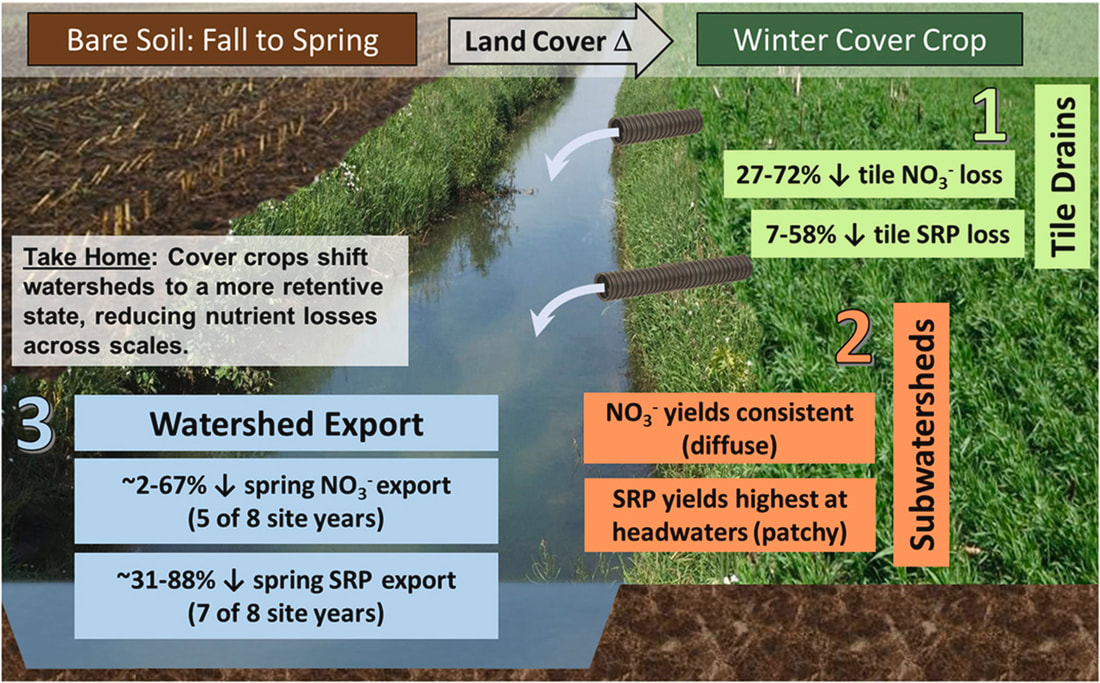


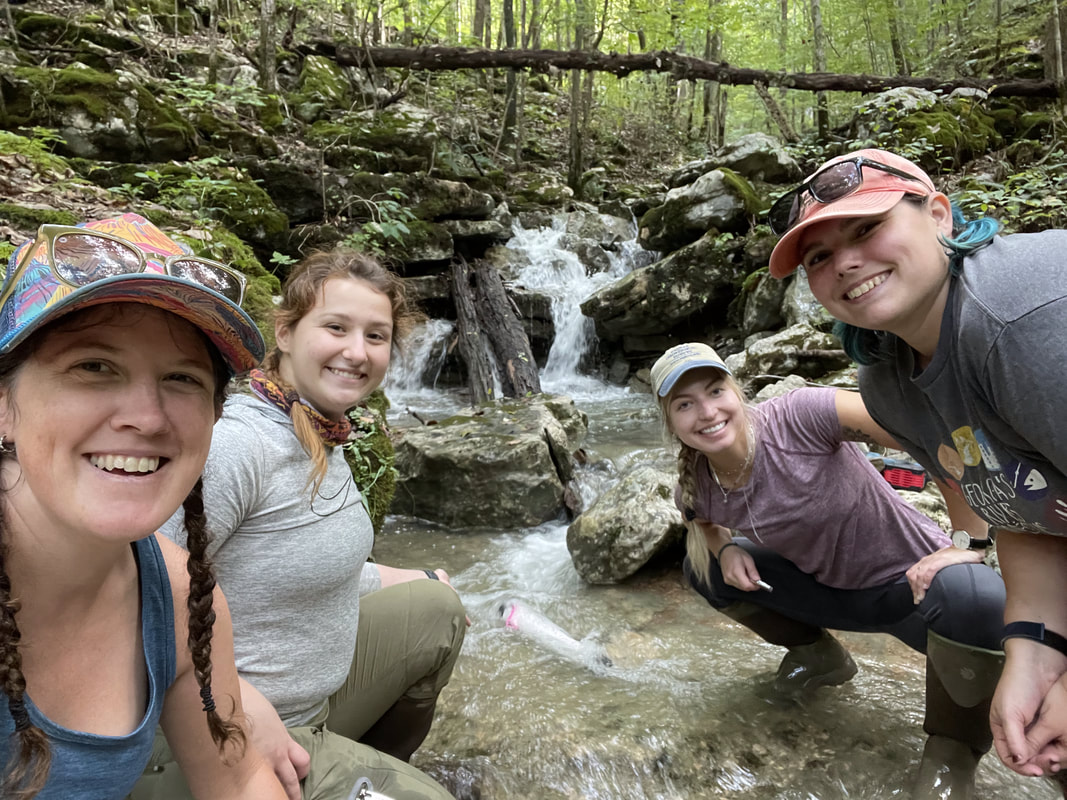



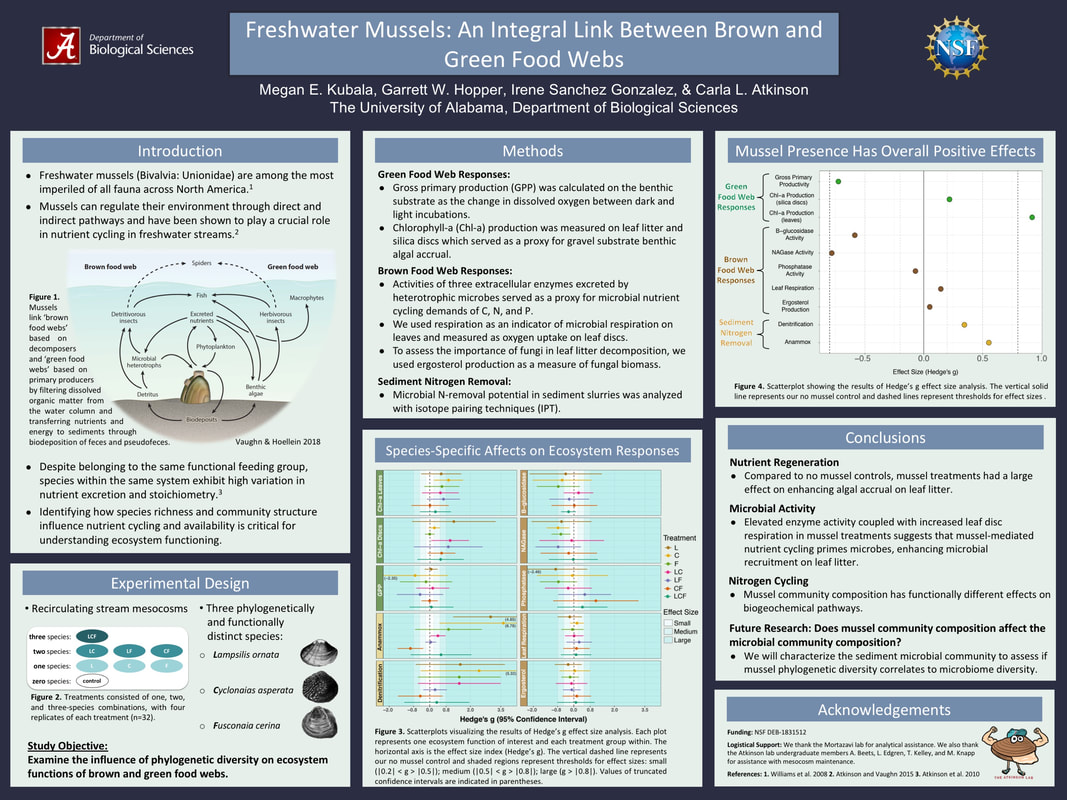

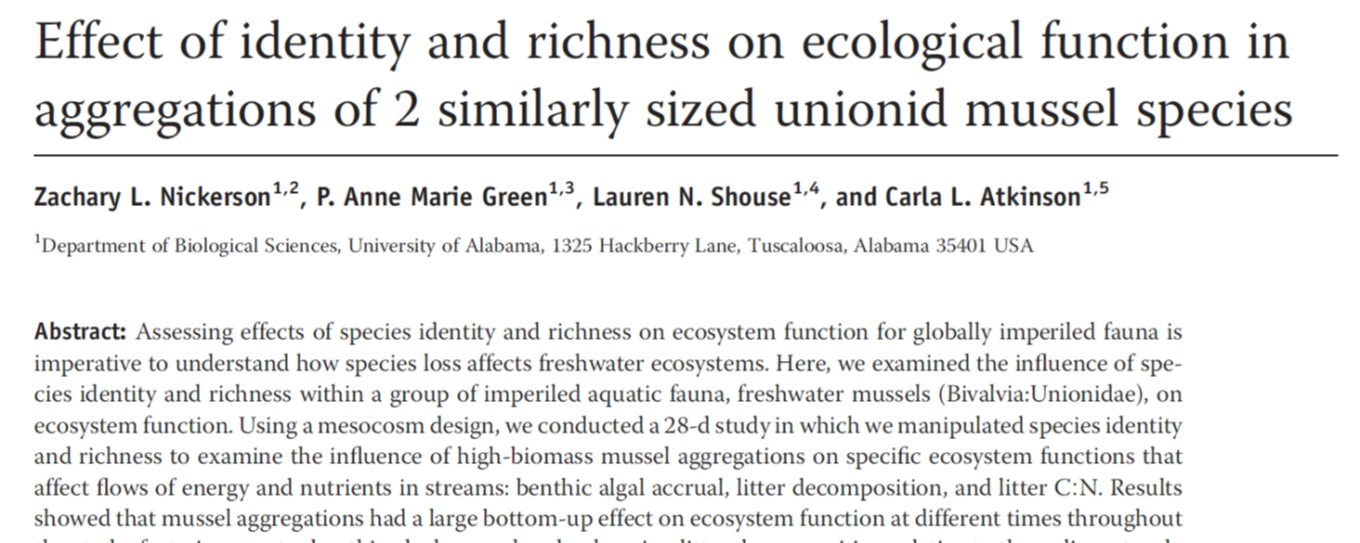
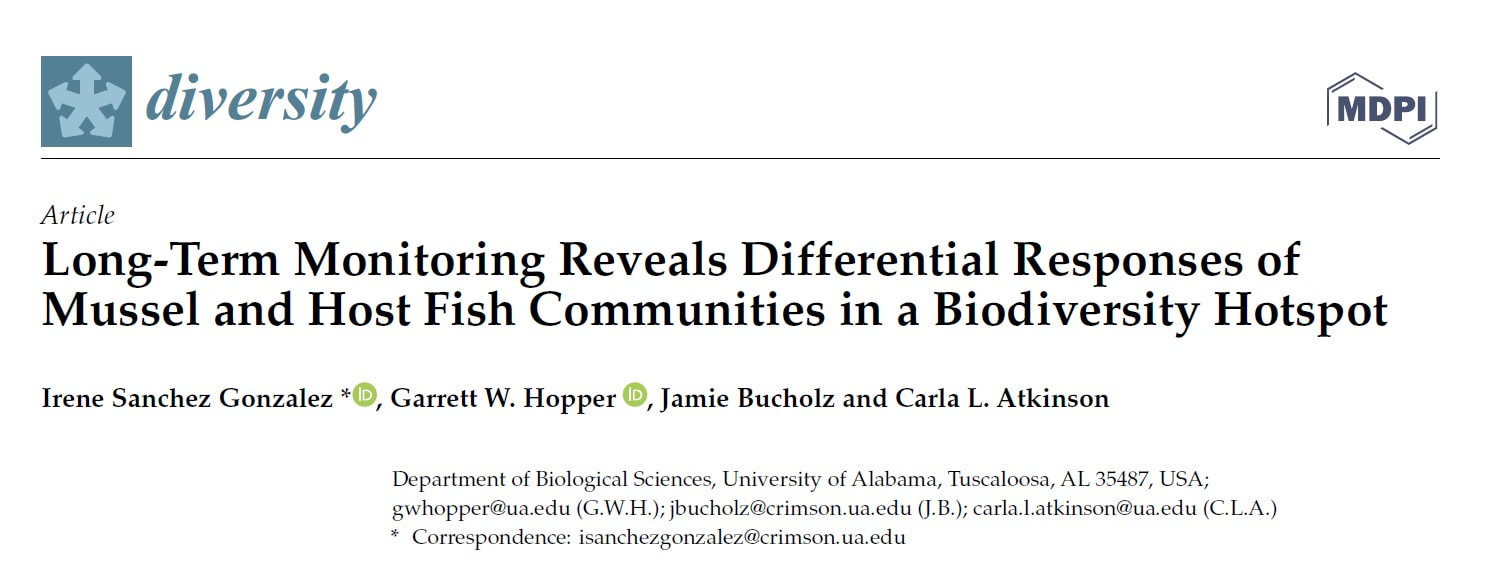


 RSS Feed
RSS Feed
